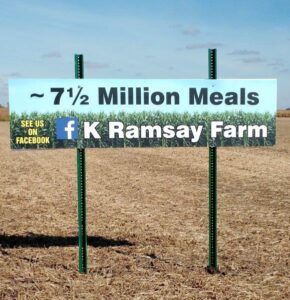Ramsay Farms shares historical, agricultural significance
Winnebago-Boone Farm Bureau
MANCHESTER – When Manchester Township in Boone County was opened for land purchases in 1838, James Ramsay and his family were already there. He and his wife Hannah Richardson purchased land from the Federal Government for $1.25 an acre, this purchase led to the beginning of Ramsay Farm.
In April 1861, sons William, Wallace (W.G.), and Nathaniel, were sent east to become part of the Army of the Potomac. Using his mustering out pay, W.G. bought 80 acres on Ramsay Road just south of where he grew up. This was the first purchase of today’s Centennial Farm. W.G. married Henrietta Peters in 1870 and they began the legacy of Ramsay Farm.
By the 1900’s the farm needed to produce something different. Dairy and other livestock were raised for more than consumption at home. The barn was expanded to the gambrel shape, as it is today, making room for hay storage and milking cows. Family lore says that W. G. exhibited the first Duroc pig at the County Fair.
By the 1930’s, W.G.’s son, Glenn, was managing the farm. Sheep, pigs, dairy cattle, chickens, and horses could be found in the buildings. Corn, oats, and hay were grown in the fields. Grapes and an apple orchard were up by the house.
During World War II, hemp was grown to make rope for the war. Glenn married Edna in 1938. Glenn and Edna’s child and W.G.’s grandson, Wallace, married Jean in 1964. They returned to the farm. All the livestock was phased out and a corn-soybean rotation was established. Using his degree, Wallace began looking at the efficiency of production in addition to improving yields.
After the 2003 harvest, Wallace retired and his son, Ken Ramsay, took over the operation of the farm. The farm site would look very familiar to past generations.
However, the practices of farming would be very different. Today, the equipment in the combine uses satellites to mark the position in the field while the equipment records crop yield and moisture. The map created by the satellite and yield data is used to apply varying rates of fertilizer based on the amount used by the crop. The corn produced today is shipped to food processors in Chicago, loaded on train cars to feed chickens in the southeast U.S., trucked to nearby ethanol plants for U.S. or European fuel use and livestock feed, or trucked to the Illinois River.
Now, Ken faces different challenges than the generations before him.
“I hope that the folks that live in Northern Illinois and Southern Wisconsin will start to slow the sprawl and realize that they can control and create a city or town that is sustainable,” Ramsay said. “We don’t have enough voters that realize the field they drive by is not a blank piece of ground waiting to be developed into something ‘valuable.’”
“The field the voter drives by today is already highly valuable – it’s been quietly providing food, economic tax dollars and spending in the communities, soaking in rainwater to replenish drinking water, and providing a quality of life for generations.”
Ramsay has recently been working on a few new projects in 2015. He has utilized two nitrogen monitoring programs with his 2015 corn crop.
“I submitted soil samples over the season for the IL N Watch program. I believe the program was initiated by FS,” Ramsay said.
He also used the Pioneer Hi-bred Encirca/DTN nitrogen program. Using a DTN weather station, rainfall is recorded on his farm; that data is combined with planting date, hybrid, soil type, and time and rate of nitrogen application, to monitor how much nitrogen is in the soil and available for the plant.
“Prior to applying nitrogen at side dress, I used the program to compare different rates against a 30-year weather data model to see if nitrogen would be available through tassel,” Ramsay said. “Pioneer had it available on a limited basis in 2014 and made the program available to all in 2015.”
You can look for pictures and posts about this program on the K Ramsay Farm Facebook page.
After watching a number of cars use his farm field to turn around when they miss a turn, Ramsay decided to see if he could find a way to let them know his story. He put up a sign that tells the number of meals provided by the Ramsay Farm according to the Illinois Farm Bureau Food Facts chart: number of people fed by farmers from 1940 to today. Ramsay feels that everyone needs to tell agricultures’ story.



